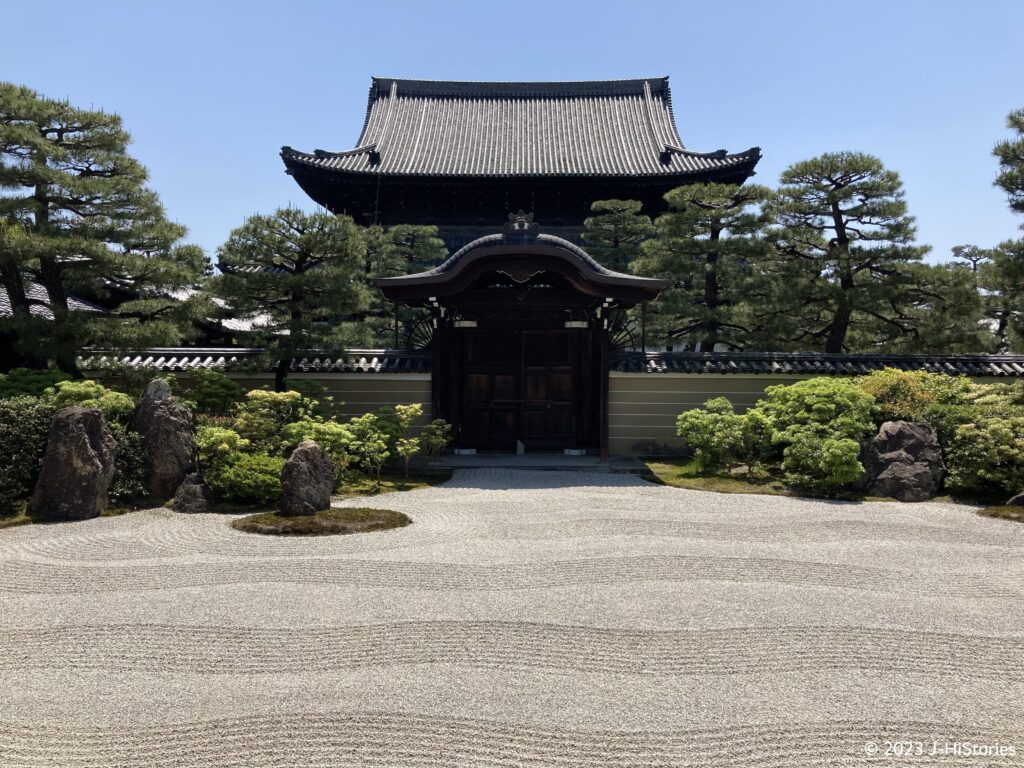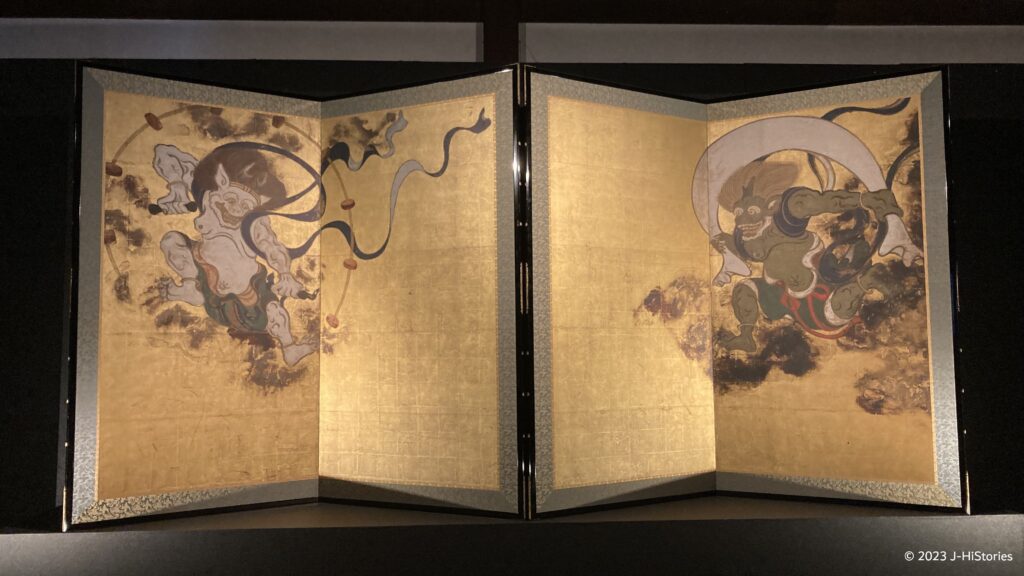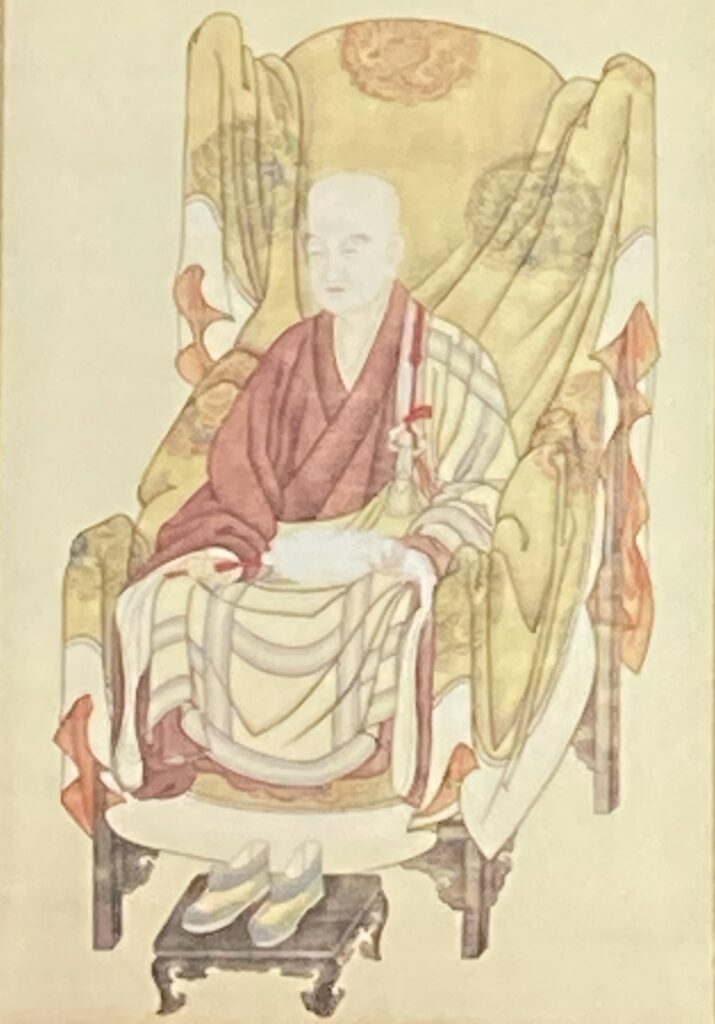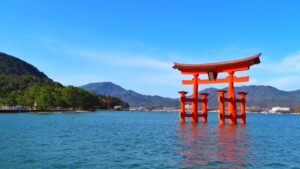Kenninji Temple, the oldest Zen Temple and beautiful Zen Garden in Kyoto
The hustle-bustle of Hanamikoji Street in the center of Kyoto is belied by the tranquility of Kenninji as the head temple of the Kenninji school of the Rinzai sect of Zen Buddhism. The Imperial Gate in front, Sanmon Gate, Dharma Hall, and Hojo Hall stand in the Zen-style straight line. After studying Zen Buddhism in the Song Dynasty, Yosai (1141-1215, 栄西) built Kenninji in 1202 under the patronage of Minamoto Yoriie (1182-1204, 源頼家), the second shogun of the Kamakura Shogunate (1185-1333), as a center for the study of the three sects of Tendai, Shingon Esoteric, and Zen Buddhism. It was not until the 11th head priest, Rankei Doryu, that Kenninji became a solely Zen temple. Why did it stand on the three sects? Why did it develop together with the Kamakura Shogunate? Let us take a look at the path of seeking that Yosai followed.

Beautiful temple with much to see
Kenninji temple is probably best known for Tawaraya Sotatsu's masterpiece, "Wind God and Thunder God Screens”. The thunder deity carrying a drum on his back on the left and the wind deity holding a windbag on the right look as though floating on a cloud painted in silver clay on a gold leaf ground. The contrast between the timeless gold ground and the ever-changing silver cloud is also interesting as if the time is expressed in this painting. The Daioen garden in front of Hojo Hall is a dry landscape garden with white sand paved over it. Sitting on the veranda, you feel as if you are facing the ocean. In contrast, the karesansui-style small garden called Choontei can be viewed from all sides. The opposite of the front side we are looking at now is the back side, and if you move to the other side, the back side becomes the front side. Is this an expression of the two sides of the same coin? The Soryu painting on the entire ceiling of the Dharma Hall depicting twin great dragons as water deities bringing rain (Dharma rain) from the teachings of Buddha is a masterpiece. You can enjoy the high-quality culture inexpressibly at Kenninji.



Great is the purity and beauty of the heart

Yosai achieved many "first" things in Japan as one Buddhist. He introduced Zen to Japan after studying it in the Sung Dynasty twice, produced the first Japanese book on Zen, "Kouzen Gokoku Ron", built the first Zen temple, and combined Zen and tea for physical and mental health, which became the foundation to spread the custom of the tea ceremony in Zen style. Yosai's motivation to devote himself to expanding Zen in Japan was well described in his words, "Great is the purity and beauty of the heart", meaning the true nature of the human mind is pure, beautiful, and great, but we have forgotten this pure mind in our daily lives. "Zazen (Zen sitting meditation) is the way to recover this great mind" in his book.
A turning point in history from a court noble society to a warrior society
At the end of the Heian period (794-1185) when Yosai lived, Taira Kiyomori was appointed the highest rank of Grand Minister of State first in Japan as Samurai. This triggered the Samurai to surpass the old court nobility. The more the power of the Taira clan advanced, the more dissatisfaction grew in various parts of Japan such as court nobles and many Samurai. Finally, another Samurai, the Minamoto clan raised the army, destroyed the Taira clan, and established the first samurai government at Kamakura. It was a time of political intrigue, battles nationwide, and natural disasters that left many suffering people in the lurch.
Yosai's true value, opening the way for Tendai monks to study Zen
Yosai continued his study at Enryakuji Temple on Mt. Hiei, the head temple of the Tendai sect. Amid doubts over whether the current Tendai sect could save people suffering in needy situations, he pursued the study of Buddhism in the Song Dynasty. However, he discovered that the teachings of the Tendai sect had declined while Zen teachings had flourished there. Yosai returned to Japan and sought Zen within the Tendai sect, only to discover that its founder, Saicho, had extensively studied Zen. In 1187, Yosai once again traveled to the Song Dynasty to deepen his understanding of Zen teaching and returned to Japan three years later, in 1191. Yosai then began disseminating Zen teachings. However, the Imperial Court, responding to Enryakuji’s appeal, prohibited Yosai from promoting Zen. Consequently, Yosai departed from Kyoto, which was dominated by the Tendai sect, and journeyed to Kamakura, the center of the emerging Samurai government.
Zen was accepted in Kamakura
Yosai's Zen (Rinzai sect) flourished in Kamakura and gained acceptance among many Samurai. He energetically promoted Zen, which led to the establishment of the Kamakura Gozan, consisting of the five prominent Rinzai sect temples: Kenchoji, Engakuji, Jufukuji, Jochiji, and Jomyoji. The Samurai of Kamakura sought a new religious path distinct from the Tendai sect, which had long enjoyed protection from the Emperor and the Imperial Court. Zen provided a spiritual haven for warriors who were prepared to face death in battle. The daily training in martial arts and spirituality undertaken by warriors resonated with the principles of Zen Buddhism, where enlightenment is attained through one's strength and discipline. Instead of relying on “salvation through Amida Buddha", known as “Tariki Hongan” advocated by the Jodo and Jodo Shinshu sects during the same period, the Samurai practiced zazen individually, aspiring to achieve salvation through training and deepening their spirituality, known as “Jiriki Hongan”.
Kenninji started standing on three sects; Tendai, Shingon, and Zen
The second Shogun of Kamakura, Minamoto Yoriie sought permission from the Imperial Court to establish Kenninji as a Zen temple. However, it was initially required to function as a temple encompassing three sects: Tendai, Shingon Esoteric, and Zen. Yosai emphasized that Zen had always been an integral part of Tendai’s tradition, as even its founder, Saicho, had studied Zen. This approach paved the way for the eventual establishment of Zen Buddhism in Japan, with Yosai teaching both Tendai and Zen at Kenninji, showcasing his unique perspective as a monk of the Tendai sect. In 1215, twenty years after Yosai's passing, the construction of Tofukuji Temple began under the patronage of Kujo Michiie, a member of the Sekkan families (*) who held high positions in the court nobility. Similar to Yosai’s vision, Tofukuji Temple also encompassed three sects. Yosai’s influence was of immense magnitude, and Zen gradually spread not only among the Samurai but also among the court nobility, including Emperor Gosaga.
* Sekkan family = the family of the regent of the Emperor
Kenninji became a purely Zen Temple
In 1259, over 40 years after Yosai died in 1215, Kenninji transformed into a purely Zen temple and significantly spread Zen teaching as the oldest Zen temple in Kyoto. His achievement stemmed from his brilliant strategy of creating an acceptable pathway for Tendai monks to explore different teachings through Zen. Now, over sitting on the veranda at the Hojo Hall, let us contemplate the profound words of Yosai, the great founder of Zen Buddhism: “Great is the purity and beauty of the heart".
Another story of Yosai's influence on later generations.
Oda Uraku, the younger brother of the powerful samurai Oda Nobunaga, who survived the Warring States period (1467-1590), constructed a tea house named Joan (a national treasure). He built it within the sub-temple of Kenninji, called Shoden Eigen-in, and devoted himself wholeheartedly to the world of tea. It is believed that he chose to pursue the path of a tea master, following in the footsteps of Yosai, who is credited with the beginning of Chanoyu (the Japanese tea ceremony).
Yosai Timeline
| 1141 | Yosai was born | Age =1 | Heian period |
| 1154 | Yosai started to study Buddhism at Enryakuji Temple | 14 | |
| 1168 | Yosai studied Buddhism in the Suy Dynasty | 28 | |
| 1175 | Hōnen attained Senju Nenbutsu | 35 | |
| 1180 | Taira Kiyomori established the first Samurai government in Japan | 40 | |
| 1185 | Minamoto Yoritomo established Kamakura Shogunate | 45 | Kamakura period |
| 1192 | Minamoto Yoritomo became Shogun of Kamakura Shogunate | 52 | |
| 1194 | The Imperial Court prohibited Yosai from promoting Zen | 54 | |
| 1198 | Started to write "Kouzen Gokoku Ron" | 58 | |
| 1202 | Yosai established Kenninji temple in Kyoto | 62 | |
| 1215 | Yosai passed away | 75 |
Recommendations to visit
- Access: 1 hour from Kyoto Station. Take bus #206 bound for "Karasumakitaoji (烏丸北大路)” at A2 or D2. Got off at "Higashiyamayasui(東山安井)" bus stop, then a 5-minute walk.


